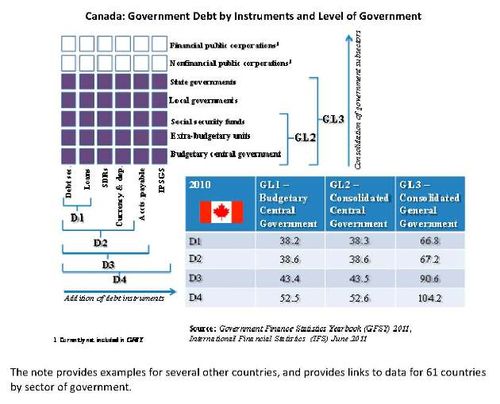Posted by Robert Dippelsman
Most key macroeconomic indicators such as GDP, the consumer price index (CPI), data on monetary aggregates, or balance of payments follow internationally accepted definitions. In contrast, public debt data can have different meanings. This problem is discussed in the recently released Staff Discussion Note What Lies Beneath: Statistical Definitions of Public Debt by Robert Dippelsman, Claudia Dziobek, and Carlos Gutiérrez Mangas of the IMF Statistics Department.
The discussion note shows that the failure to adopt global standards can lead to important misunderstandings because of the potentially large magnitudes involved. However, international guidelines on the compilation of public sector debt are well established and set out in the recently published Public Sector Debt Statistics Guide: Guide for Compilers and Users (Debt Guide). The note identifies some key dimensions of public sector debt that need to be considered:
- Institutional coverage. For example, some countries publish data either including or excluding state and local governments, civil servants' pension funds, and public corporations.
- Instrument coverage. Debt data sometimes only include two out of the six debt instruments: debt securities and loans. Other debt instruments such as other accounts payable or pension obligations to current and former employees are often not taken into account.
- Valuation: Face, nominal, and market values valuation methods can be used.
- Consolidation refers to the process of netting out intra-governmental obligations.
- Gross and net debt. While much of the policy debate is centered around gross debt, some countries have begun to publish and focus policy analysis on net debt (debt liabilities minus corresponding financial assets). In many cases the method of valuation is not explicitly mentioned even though market versus nominal valuation can be a significantly different number.
Many data users are not aware of the extent to which differences in concepts and methods matter. The table below shows a range of values for Canada’s 2010 government debt, depending on the level of government and range of financial instruments covered. The paper develops a nomenclature to help users navigate through the various concepts. For institutional coverage, the terms go from GL1 (Government Level 1, for the narrow coverage of budgetary central government) to GL5 (the broadest coverage including all levels of government as well as government-owned corporations). For coverage of financial instruments, the terms go from D1 (debt securities and loans) to D4 (widest range of debt instruments). In this vein, we can say that Canada’s GL1 D1 was 38 percent of GDP in 2010, while its GL3 D4 was 104 percent.

Note: The posts on the IMF PFM Blog should not be reported as representing the views of the IMF. The views expressed are those of the authors and do not necessarily represent those of the IMF or IMF policy.





